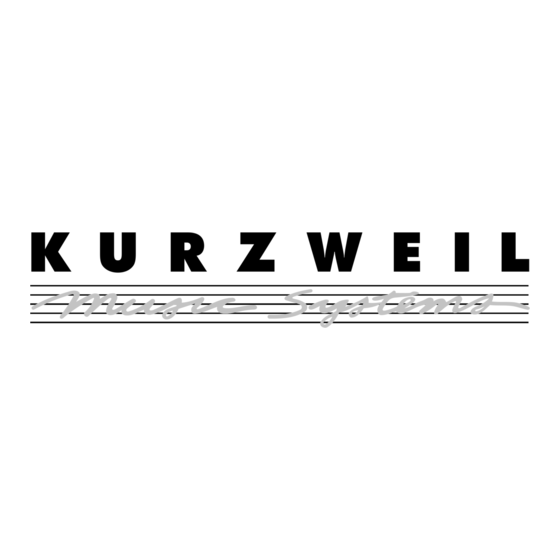Table of Contents
Advertisement
Quick Links
Chapter 5
Editing Conventions
Introduction to Editing
Programming (editing) the K2600 always involves three basic operations: mode selection,
navigation, and data entry.
First, select the mode that relates to the object you want to editÑa program, a setup, etc. Then
select the object you want to edit, and press the Edit button to enter the editor within that mode.
An editor contains all the parameters that deÞne the object youÕre programming.
Next, you navigate around the editorÕs page(s) with the soft buttons, and select parameters with
the cursor (arrow) buttons. When youÕve selected a parameter (its value is highlighted by the
cursor), you can change its value with one of the data entry methods. When you change a value,
youÕll normally hear its effect on the object youÕre editing. The K2600 doesnÕt actually write your
editing changes to memory until you save the object youÕre working on. It then allows you to
choose between writing over the original object, or storing the newly edited version in a new
memory location.
What's an Object?
If youÕve been wondering what we mean by the term Òobject,Ó itÕs an expression we use for
anything that can be named, saved, deleted, or edited. HereÕs a list of all the types of objects:
Samples
Keymaps
Programs
Setups
Songs
Studios
FX presets
Quick Access banks Factory-preset or user-programmed banks of ten entries each, that store
Velocity maps
Digital recordings of instrumental sounds or waveforms. Samples
actually have two separate parts: the actual sample data and the sample
header information, which contains start, alternative start, loop, and end
points, as well as other information like tuning and volume.
Collections of samples assigned to speciÞc velocity ranges and/or keys.
Factory-preset or user-programmed sounds stored in ROM or RAM.
A program is one or more layers of sound, with programmable DSP
functions applied to the keymaps within each layer.
Factory-preset or user-programmed MIDI performance presets consisting
of up to eight zones, each with its own program, MIDI channel, and
controller assignments, and (optionally) arpeggiation speciÞcations.
Sequence Þles loaded into RAM, or MIDI data recorded in Song mode.
Factory-preset or user-programmed conÞgurations of the K2600Õs
onboard digital audio effects processor.
Factory-preset or user-programmed dataÑincluding effects algorithms,
levels and balanceÑthat deÞne the nature of studios.
programs and setups for single-button access in Quick Access mode.
Factory-preset or user-programmed curves that affect the K2600Õs
response to, and MIDI transmission of, attack velocity values.
Editing Conventions
Introduction to Editing
5-1
Advertisement
Table of Contents

Summary of Contents for Kurzweil K2600 - MUSICIANS GUIDE REV A PART NUMBER 910330 CHAP 5
-
Page 1: Chapter 5 Editing Conventions
Editing Conventions Introduction to Editing Chapter 5 Editing Conventions Introduction to Editing Programming (editing) the K2600 always involves three basic operations: mode selection, navigation, and data entry. First, select the mode that relates to the object you want to editÑa program, a setup, etc. Then select the object you want to edit, and press the Edit button to enter the editor within that mode. -
Page 2: Object Type And Id
Editing Conventions Object Type and ID Pressure maps Factory preset or user-programmed curves that affect the K2600Õs response to, and MIDI transmission of, pressure (aftertouch) values. Intonation tables Factory preset or user-programmed tables that affect the intervals between the twelve notes of each octave. Master tables The values that are set for the global control parameters on the Master-mode page, as well as the settings for the parameters on the... -
Page 3: Saving And Naming
Editing Conventions Saving and Naming change numbers (when youÕre using the Extended or Kurzweil Program Change formatÑsee Program Change Formats on page 10-11). The object type and ID enable you to store hundreds of objects without losing track of them, and also to load Þles from disk without having to replace Þles youÕve already loaded. -
Page 4: Rom Objects
Editing Conventions Saving and Naming press the button again. Press the +/- button on the alphanumeric pad to switch between upper and lower case characters. Press 0 one or more times to enter the numerals 0 through 9. Press Clear (on the alphanumeric pad) to erase the selected character without moving any other characters. - Page 5 Editing Conventions Saving and Naming way, since you canÕt truly write to ROM. The ROM object will reappear if you delete the newly edited object (there are soft buttons in each editor for deleting objects). RAM Objects If the original object was a RAM object, the K2600 will assume you want to replace it, and will suggest the same ID as the original object (if it has an asteriskÑ*Ñbetween its ID and its name, itÕs a RAM object).
-
Page 6: Deleting Objects
Editing Conventions Deleting Objects Deleting Objects Within most editors, there are soft buttons for deleting objects. When you want to delete an object, press the Delete soft button, and the K2600 will ask you if you want to delete the object. (At this point in the dialog, you can select another object with any of the data entry methods.) Press OK if you want to delete it, or press Cancel if you donÕt. -
Page 7: Saving And Loading Files-Disk Mode
Editing Conventions Special Button Functions YouÕll want to think about organizing your edited objects in the memory banks when you start using the ßoppy disk drive or a SCSI device to store your programs, samples, and other objects. Objects that are stored in the same memory banks can be easily stored in the same Þle on diskÑ which generally is a good idea. - Page 8 Editing Conventions Special Button Functions When youÕre in the Sample Editor, the Program, Setup, Q Access, MIDI, Master, and Song mode buttons function according to the orange labeling near each button. Table 5-1 describes all of the special button functions. Button Mode or Editor White...





